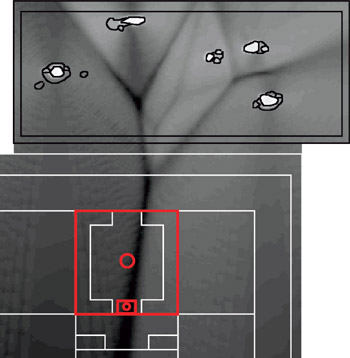Zen Garden
Air Date: Week of August 22, 2003
Scientists in Kyoto have discovered what may be behind the extraordinarily calming effects of Japanese Zen gardens. Host Steve Curwood discusses these findings with researcher Gert Van Tonder.
Transcript
CURWOOD: Japanese zen gardens are landscaped with raked gravel and carefully placed rocks and moss. And although they look sparse and bare, these can have a strong calming effect, as I found out once when I visited the Ryoanji Zen Garden in Kyoto a few years ago.

Now, a team of scientists is saying that the rocks and moss there conceal an image of a tree that exists only our minds. Gert Van Tonder, a visual cognitive researcher at Kyoto University, explains what happened when his team started doing mathematical computations with the patterns in the garden.Now, a team of scientists is saying that the rocks and moss there conceal an image of a tree that exists only our minds. Gert Van Tonder, a visual cognitive researcher at Kyoto University, explains what happened when his team started doing mathematical computations with the patterns in the garden.
VAN TONDER: I first thought I would just get a scattered pattern of lines going off into various directions. But it turns out that the medial access lines in the simulation form a converging pattern. And it converges onto the main viewing area of the veranda in the temple.
And this converging structure resembles a tree. We did a number of analyses on these branches. And, for example, we found that, if anybody would just randomly throw their rocks onto that piece of gravel, they wouldn’t nearly come close to finding such a nice converging tree structure.
CURWOOD: How would you explain this to our listeners? How do you explain the idea of seeing a tree in negative space?
VAN TONDER: Try to image to see a tree that’s invisible, except for its leaves. So, in a similar way, in the garden here, the rocks form the leaves of this invisible tree. And while you’re not necessarily aware of it, the branches and the trunk is right there in front of you.

CURWOOD: How much do you think the designers of this garden were aware, or knew about, the subconscious picture that they were creating?
VAN TONDER: Well, I think we would be a bit reluctant to say that they consciously thought of a tree structure, and then went ahead with the design. But they must have had a very highly developed or sophisticated intuition of their own subconscious perception so that they could adjust the rocks and, thereby, also this invisible tree until it felt just right.
CURWOOD: How important is it for the calming effect that a tree is the image that’s implied?
VAN TONDER: Well, I think I can only answer with a puzzle. The image of a tree in Buddhism is important in the story about the moment when the Buddha finds enlightenment. And he does so at the foot of a tree. So, that could be a possible clue for people who want to think about this.
CURWOOD: Thanks for speaking with us today.
VAN TONDER: It’s a pleasure.
[MUSIC: Moby “Porcelain” Winter Chill 2 Hed Kandi (2000)]
Living on Earth wants to hear from you!
Living on Earth
62 Calef Highway, Suite 212
Lee, NH 03861
Telephone: 617-287-4121
E-mail: comments@loe.org
Newsletter [Click here]
Donate to Living on Earth!
Living on Earth is an independent media program and relies entirely on contributions from listeners and institutions supporting public service. Please donate now to preserve an independent environmental voice.
NewsletterLiving on Earth offers a weekly delivery of the show's rundown to your mailbox. Sign up for our newsletter today!
 Sailors For The Sea: Be the change you want to sea.
Sailors For The Sea: Be the change you want to sea.
 The Grantham Foundation for the Protection of the Environment: Committed to protecting and improving the health of the global environment.
The Grantham Foundation for the Protection of the Environment: Committed to protecting and improving the health of the global environment.
 Contribute to Living on Earth and receive, as our gift to you, an archival print of one of Mark Seth Lender's extraordinary wildlife photographs. Follow the link to see Mark's current collection of photographs.
Contribute to Living on Earth and receive, as our gift to you, an archival print of one of Mark Seth Lender's extraordinary wildlife photographs. Follow the link to see Mark's current collection of photographs.
 Buy a signed copy of Mark Seth Lender's book Smeagull the Seagull & support Living on Earth
Buy a signed copy of Mark Seth Lender's book Smeagull the Seagull & support Living on Earth

